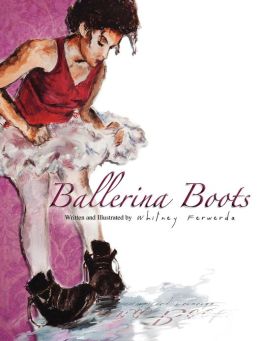Walk your own walk, says USU alum in her book, ‘Ballerina Boots’
April 13th, 2013 Posted in Arts and LifeBy Dani Hayes
LOGAN—She wants her story to be up for interpretation. She wants her readers to make it mean something personal to them. The story encompasses open-ended symbolism, from the ballerina to her boots.
 Whitney Ferwerda, author and illustrator of Ballerina Boots, is a walking representation of the message of her book—to find your path in life and walk it in confidence while respecting other people’s paths.
Whitney Ferwerda, author and illustrator of Ballerina Boots, is a walking representation of the message of her book—to find your path in life and walk it in confidence while respecting other people’s paths.
“I had always seen this need in our world that we can be so much better if we just listen to other people, even if we don’t agree with them,” said Ferwerda, a 2010 USU graduate. “There are still so many things that can be learned.
“I have always seen that need and wanted to do something to promote awareness,” she said. “I think the key to creating a more equal and collaborative world is just respecting diversity, honoring diversity.”
Ferwerda’s story starts with an “adorable ballerina” who begins to feel uncomfortable in her scratchy ballerina tutu and uncomfortable slippers. The “tall people” praise her, remarking how beautiful she looked as a ballerina. She endured because it made the “tall people” happy, with a promise that if “you will stay in the costume, you will always be happy.”
• Find Ballerina Boots on Facebook and at the Blue Crow Book Nook.
Ferwerda’s broad language and use of symbolism allows readers to put themselves, or others, in the story and to fill in details with their own lives, she said. “I want to have the reader make what it means to them.”
Ferwerda’s idea for Ballerina Boots developed from her own personal journey. “The whole ballerina persona was how I was taught to grow up,” she said. “The people who loved me, the people who I had looked up to, said, ‘Whitney, this is what you need to be. This is how you will be happy, how you will succeed.’
“In the beginning, I believed them. I loved them. I looked up to them—parents, family, friends and even people I had admired. That’s why I put in the ‘tall people’—people I literally looked up to.”
Ferwerda was faced with an internal battle of pleasing the “tall people” while sacrificing her own comfort. Eventually, this became a drive toward action.
“I think that inner battle becomes even stronger when the people you love and trust tell you something different than what you feel or do,” she said. “It’s like a kid whose dad is training him in his business so he can work there when he grows up. Well what if he wants to be an astronaut?”
As for Ferwerda’s ballerina—she wanted to be a cowgirl. During a particular dance class, while wearing the slippers, the ballerina sees her reflection in the mirror and sees herself wearing boots. “Those boots look like something I would like to wear, she thought to herself. I think my feet would feel better in those.”
The ballerina got a glimpse of who she truly was, and she yearned for that reality.
“The boots represent your true self, who you really are,” Ferwerda said. “The reason the ballerina gets glimpses of them is because she never really thought to think about who she was at that point because she was already told who she was. They are about getting in touch with who you are, loving that and being comfortable with that.”
For Ferwerda herself, an important part of her own journey was coming to terms with her sexuality.
“It felt like me,” she said. “It felt like something I couldn’t deny. It wasn’t something that I just couldn’t take off—they were my boots.”
Everyone has that same personal pair of “boots,” said Ferwerda, and she wants to emphasize the diversity of boots in the world.
“My hope is that everyone can relate to it,” she said. “Just because you are doing it differently doesn’t mean that you are doing it wrong.”
She wanted to write her book in a way that any person who felt different could see themselves as the ballerina in search for their own boots.
Longtime friend and a fan of Ferwerda’s book, Joanna Jenkins, sees herself in the book as well as her 4-year-old daughter.
“I love how it encourages being yourself,” said Jenkins, a school psychologist in the Nebo School District “I love that you can read into it different things.”
Jenkins shared Ballerina Boots with her daughter because of the similarities she sees and the message the book shares.
“My daughter loves it because she literally wears tutus and boots every day,” she said. Tia’s everyday outfit consists of a Batman t-shirt, a tutu, polka-dot leggings and boots, with her hair unkept.
“She gets mad when I try and do her hair,” Jenkins said. “It’s a wild, untamed look—clothes and hair.”

‘I’m Iron MAN,’ says Tia Jenkins, who isn’t shy about her clothing preferences. Photo courtesy of JOANNA JENKINS
Ballerina Boots shows that steering away from gender-specific interests is OK, Jenkins said. Tia was dressed as Iron Man for Halloween last year, and didn’t like it when people said that she was actually Iron Girl. “No, I’m Iron Man,” she told them.
Jenkins loves her daughter’s unique personality, and encourages her to be herself, like the ballerina in Ferwerda’s book.
After the ballerina discovers her boots, she excitingly tells the “tall people,” and is disappointed by their reaction: “But little girl, boots will not go with your costume,” they tell her. Not wanting to disappoint, the little girl tries to forget about her boots.
“There’s a certain amount of, ‘I don’t want to let them down,’” Ferwerda said. “But I didn’t know how to be authentic and not let them down.”
This is one main struggle Ferwerda faced during her own journey toward her “boots”—feeling comfortable without disappointing those she loved. As she continued, she did find support on her journey.
“Each time I would take a step out, I would just get this increasing affirmation saying, ‘Yes, you are on your path,’” she said. “People came into my life, and experiences. Once when you are on your path, you’re kind of attracted to these things that keep you going.”
Specifically, she says, she found relief in asking questions. “I had so many questions,” Ferwerda said, “and just by asking them, there were new people with new perspectives that I had never thought of before.”
But it takes a leap, she said.
“It takes courage to say, ‘This is my path. Let me be on my path,’” she said. “I think your opportunities open up more. I think the things you see and learn are so much bigger. I think that your potential to help others is so much bigger. You are no longer limited . . . We need ballerinas, but we also need people to go explore the mountains.”
Ferwerda takes joy in the world’s diversity, and says she hopes her book’s message will evoke more diversity to come out. That will happen if we learn to listen to each other, she said.
“I had always seen that need in our world,” she said. “If we just listen to other people, even if we don’t agree with them, there are still so many things that can be learned.
“Isn’t that the beauty of collaborating—that you’re not always right? Isn’t that the purpose? That we don’t want to all be on the same page?” she asked. “Now I am willing not to be right. I’m willing to acknowledge that I don’t have all the answers. It gives me the ability to learn and to get better.”
As the book’s plot unfolds, the ballerina receives more confirmation and more help as she experiences her new boots.
Ferwerda ends her book with her own original painting of the “adorable ballerina,” all grown up and in her 20s. She is seen walking away from the viewer, wearing a baggy blue t-shirt, brown knee-length shorts and her boots. In her left hand she is holding her childhood ballerina slippers and in the other, a little blonde girl’s hand.
Ferwerda explains that everyone has a past that has molded them into who they are that cannot be forgotten.
“Even though the ballerina knew she needed to go more places than she could in her slippers, they still meant a lot to her; they still were a part of her.” she said. “That was her life so she just doesn’t want to discard it.”
The message in Ballerina Boots is just to keep going because it’s worth it.
“Everyone deserves to be who they are and not have to edit,” Ferwerda said. “You have more to give than that.”
TP
Tags: Ballerina Boots, Blue Crow Books, self-discovery, Whitney Ferwerda


Sorry, comments for this entry are closed at this time.